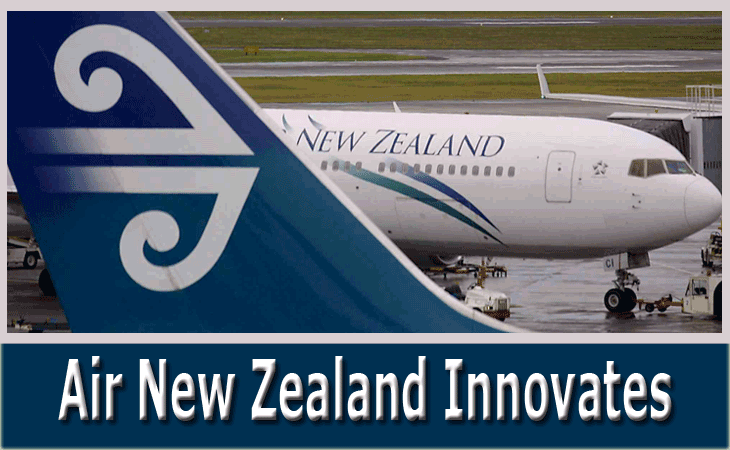| 
 FlyingTypers
recently caught up with the delightful Rick Nelson, Air New Zealand GM
Cargo. He said an ever-expanding network of global partnerships was helping
the carrier extend its reach, bolstering the country’s economy in
the process and enabling New Zealand PLC to reach the world’s most
lucrative markets. FlyingTypers
recently caught up with the delightful Rick Nelson, Air New Zealand GM
Cargo. He said an ever-expanding network of global partnerships was helping
the carrier extend its reach, bolstering the country’s economy in
the process and enabling New Zealand PLC to reach the world’s most
lucrative markets.
As the frequent labor disputes, financing
difficulties, and restructurings of Qantas in neighboring Australia have
illustrated in recent years, end of the line carriers can find it hard
to breathe in global air cargo and passenger markets driven increasingly
by volume and critical mass.
Air New Zealand Cargo has had to innovate
as the airline negotiated its path amongst the giants of world aviation.
As Nelson explains, the continued decline of some traditional point-to-point
markets has prompted Air New Zealand to develop interline partnerships.
These have now been established with some 50 Airlines and 11 land-based
carriers, extending the carrier’s reach into profitable, high demand
markets and offering New Zealand’s exporters and importers a valuable
link to the wider business world.
“As a relativity small carrier our
ability and preparedness to be flexible, nimble, and to innovate is often
a key point of difference for our customers,” he said.
“We have worked hard on improving
our alliance relationships, ensuring we are working with likeminded and
service oriented partners.
“The extension of our network has
allowed us to meet the ever changing needs of our customers and to further
develop our presence into new and emerging markets.”
While integrating its cargo network with
its new range of partners, over the past two to three years Air NZ Cargo
has also focused heavily on ensuring that as an organization it has the
right personnel and capability in the right places. “We have increased
our account management and sales presence in almost every market that
we serve and we are committed to investing in building the sales capability
within our teams in a way that will continue to differentiate us from
our competitors,” said Nelson.
The extension of the carrier’s “virtual
network” via its system of partnerships is being backed up with
some financial heft over the next 12 months via the introduction of a
new, fully automated One Piece Handling System for import and transshipment
cargo. Nelson expects this to “further differentiate” Air
NZ Cargo’s services from competitors and ensure seamless import
and transship processes across its global network.
In FY13 the carrier saw both an increase
in cargo volume and yield, and further progress is expected over the rest
of this year. “We had strong market growth in the first half of
2014 and we project that there will be moderate volume growth in the coming
6-12 months,” said Nelson. “There has been increased volume
available to/from the US, Middle East and Europe.
“However increased capacity in these
markets has seen some carriers reduce rates to capture volume. These actions
have driven a negative change in the volume/value ratios.”
Air New Zealand is also expanding its fleet
which currently takes in: 2 x 747-400, 6 x 777-300ER, 8 x 777-200ER, 5
x 767-300ER, 13 x Shorthaul A320-200, 9 x Domestic A320-200, 7 x 737-300,
15 x ATR 72-500 and 600, 23 x Bombardier Q300 and 18 x Beech 1900D.
“We have recently taken delivery of
the first of two new 777-300 aircraft and the first of ten 787-900 on
order are set to arrive next month,” said Nelson. “The new
additions to our fleet will provide increased capacity into some of our
key sectors in the later part of this year.
“Air NZ has also recently signed a
deal to purchase 13 new Airbus A320/A321 neo aircraft. The first of these
is due for delivery in 2017.”
The fleet additions will see routing changes
and increased capacity added into the market in the third/fourth quarter
of 2014. “From a cargo perspective, we will experience strong capacity
growth into and out of Japan and China with the introduction of the new
787-9 aircraft,” explained Nelson. “This additional capacity
offers excellent growth opportunities for our New Zealand and Pacific
Island customers as well as increased access to the New Zealand market
from China and Japan.
“We also have significant capacity
growth to and from the North American market, which opens up additional
opportunities to access USA, South America, and Europe for our North Asian,
Australian, and New Zealand customer base.
“This capacity increase also creates
the opportunity for our UK, European, and American customers to grow their
business portfolios to New Zealand and Australia.”
SkyKing
|





